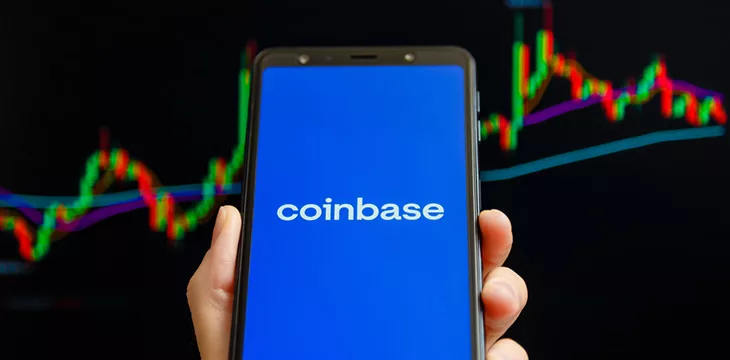|
Getting your Trinity Audio player ready...
|
Coinbase (NASDAQ: COIN) narrowed its losses in the first quarter of 2023, but nearly all of the digital asset exchange’s growth streams appear to be living on borrowed time.
Figures released Thursday show Coinbase generated revenue of $736 million in the three months ending March 31, a nearly 37% decline from the same period last year but $129 million better than the $605 million generated in Q4 2022.
However, the gains were artificially goosed by the rise in the fiat value of most high-profile tokens since the year began, i.e., something utterly beyond Coinbase’s control. Moreover, the gains weren’t enough to prevent the fifth consecutive quarter of negative profits, although Q1’s $79 million loss was the ‘best’ result in over a year.
Revenue from trading commission fees was up 16.3% from Q4 to $374.7 million, although that’s still only getting back to where things stood in Q3 and barely two-thirds of the Q122 figure. Interestingly, Q1 trading volume was flat sequentially at $145 billion, suggesting Coinbase is squeezing users even harder than usual to make up the numbers.
As further evidence of this phenomenon, retail customer transaction fees gained 14% sequentially to $352 million, despite trading volume rising only 5% to $21 billion. Institutional traders generated revenue of $22 million, up 67% sequentially, although institutional volume fell by $1 billion to $124 million.
These numbers testify to what the Financial Times recently called the ‘unloved rally’ currently making the crypto markets look less anemic. While the fiat value of tokens such as BTC may be up 70% year-on-year, trading volume is so thin that a 1% rise in BTC’s value can currently be accomplished by moving around 462 tokens, whereas achieving the same rise four months ago required moving 1,400 tokens.
On Thursday’s analyst call, Coinbase CFO Alesia Haas was asked about the sustainability of the exchange’s notoriously punitive retail trading fees, which short-seller Jim Chanos has called ‘insanely high.’ Haas confirmed that Coinbase “increased our spread” on retail trades in Q1 but claimed “consumers have a choice” between using the basic exchange or the Advanced model.
Queried as to how Coinbase determines how tight retail traders can be squeezed before there’s either a consumer revolt, Haas said only that Coinbase was “monitoring price elasticity.” Asked whether regulators might start probing whether the exchange is price-gouging its retail customers, chief legal officer Paul Grewal said Coinbase was “constantly evaluating these issues.”
But fear not, crypto proles! Coinbase is an equal opportunity gouger. Haas stated that the exchange also “rolled back certain discounts for our market-makers” during the quarter, which led to “an increase in the take rate and the pricing on the institutional side based on that decision.”
Coinbase’s own monthly transacting users (MTUs) during Q1 fell 9% year-on-year to 8.4 million, although this was a modest improvement on 2022’s 8.3 million average. However, the definition of MTUs includes anyone who ‘passively transacts’ at least once per month, which is a pretty broad brush with which to paint ‘activity.’
A closer look at Coinbase’s volume shows the exchange is leaning heavily on trades of tokens other than BTC or ETH. The ‘other crypto assets’ segment accounted for 45% of Q1 volume, up from 33% in Q422, largely due to a nine-point drop in ETH volume to 24%.
This rising memecoin reliance is particularly bad given that U.S. Securities and Exchange Commission (SEC) tends to view most utility-free tokens as unregistered securities, so this revenue stream could quite literally evaporate overnight should Gary Gensler wake up on the bad side of his bed.
Thanks, Jerome Powell!
Transaction fees’ share of Coinbase’s overall revenue continues to shrink, representing less than 51% of Q1’s total, down from 87% in the same period last year. The ‘subscription and services revenue’ segment came within a whisper of eclipsing fees last quarter, more than doubling year-on-year to $361.7 million, and up nearly 28% from Q4.
The star of this segment remains interest income from custodying customers’ USDC, the stablecoin issued by Circle via the Centre consortium (in which Coinbase is the only other partner). Thanks to the rise in interest offered by U.S. T-bills, Coinbase’s interest income hit $240.8 million in Q1, nearly one-third higher than Q4, dwarfing the $10.5 million generated in the same period last year.
Nearly $200 million of Q1’s interest income came via USDC, which has undergone significant shrinkage since mid-March. With USDC’s market cap down by nearly one-quarter, Q2’s numbers will take a hit, although Coinbase says it’s trying to mitigate this by making the USDC Rewards program available to institutional clients and continuing to “experiment with optimizing Retail Rewards.”
Speaking of, the ‘blockchain rewards’ segment was up 18% sequentially to $72.7 million, but last month’s ‘Shanghai’ upgrade to the Ethereum network allowed ETH stakers to finally reclaim their assets, resulting in a net outflow of nearly $400 million from Coinbase to date. So, this vertical is also likely to report a hit in Q2.
Custodial fee revenue was up nearly one-half to $17 million, but much of this came via a deal with the MakerDAO community. The said community recently renegotiated its deal with Coinbase to nearly double the interest rate the exchange had been paying, and MakerDAO plans to withdraw all its USDC within a year in favor of a self-custodial solution, so this is another vertical that’s in for a rude awakening.
‘Other subscription and services’ revenue gained nearly 13% sequentially to $30.1 million.
Coinbase’s bottom line would have been far worse had it not engaged in multiple rounds of significant staff culls, which resulted in $144 million in restructuring charges in Q1. However, this new “scrappier approach to investments” resulted in the lowest quarterly operating expenses in two years.
Coinbase shares closed Thursday up 1.5% to $49.22 but jumped another 8.3% to $53.32 in after-hours trading.
It’s just a flesh wound
Coinbase’s growing ‘rewards’ vertical could vanish entirely should the SEC follow up on the Wells notice it sent Coinbase with a total shutdown of its staking programs (mirroring what happened to rival exchange Kraken earlier this year).
Last month, Coinbase sued the SEC to compel the regulator to respond to its July 2022 petition for more regulatory clarity on digital assets. On Wednesday, the U.S. Third Circuit Court of Appeals gave the SEC 10 days to respond to that petition, after which Coinbase will be given seven days to file any reply.
Asked about Coinbase’s confrontational approach to the SEC, Grewal warned that the legal process “could be lengthy.” Grewal said Coinbase remained “open to dialogue with the SEC wherever it makes sense” but was “fully committed if necessary” to defend itself in court.
Asked what impact Coinbase’s regulatory difficulties were having on operations, Haas insisted it was “business as usual,” and she saw nothing that would “derail” the company from its lofty goal of returning to profitability at some point this century. Haas added that staking represented just 3% of Coinbase’s net revenue, and 20% of its business is international and thus outside the SEC’s purview.
We’re not sure what metric Haas is basing that figure on because Coinbase’s 8-K filing indicates that nearly 89% of Coinbase’s Q1 revenue came from U.S.-based customers. Worse, that’s seven points higher than the U.S.-based share from Q1 2022.
Base(d)
In February, Coinbase launched Base, an Ethereum-based Layer 2 network intended to offer “a safe, low-cost, developer-friendly way to build on-chain.” On Thursday, an analyst asked how, given the threats to the other revenue streams, Coinbase intended to monetize this product to which it was devoting scarce resources.
Coinbase CEO Brian Armstrong said it was “too early to say” how Base could be monetized, noting that it was still in a testnet phase and the focus for now was “trying to build out the ecosystem.” Armstrong emphasized that there were still no ‘current’ plans to issue an in-house Base token, adding there was “no way to register” such an obvious security in the U.S. at the moment.
Armstrong also tempered expectations that Base would lead Coinbase to launch its own decentralized exchange (DEX), although he stated the company “wants to play” in both the DEX and centralized exchange worlds.
Haas downplayed revenue expectations for Coinbase’s new Bermuda-based derivatives platform, noting that there were currently only two order books (BTC-USDC, ETH-USDC), but there were “large volume opportunities” if they could steal market share from sketchy derivatives demigods Binance.
Coinbase borrow
No analyst queried the execs on Wednesday’s announcement regarding the mothballing of the ‘Coinbase Borrow’ program, which allowed customers to borrow real cash by pledging BTC as collateral. But the earnings report noted that Coinbase had $473 million in total credit and counterparty risk (excluding banks) at the end of Q1, including $193.7 million in “loans to customers.”
The other portions of this $473 million included $79 million in ‘collateral posted’ for hedging borrowing transactions “in connection with our financing products.” There’s also $200.2 million in “cash held at 3rd party venues,” which include not only banks but also “payment providers and cryptocurrency companies.” However, Coinbase claims that the latter category contributed nada to this sum by the end of Q1.
Coinbase’s 8-K filing cites $170.6 million in ‘crypto assets borrowed’ and $200 million in ‘crypto assets borrowed repaid with crypto assets.’ To make things even more confusing, a different ‘crypto assets borrowed’ entry cites $119.7 million with the caveat that they are ‘recorded at fair value.’
An explanatory note states that when Coinbase borrows crypto, “it may be required to pledge collateral and is required to pledge additional assets to maintain its required collateral percentage. The lender may have the right to use the collateral. If the lender has the right to use the collateral or if the collateral is fiat, the Company derecognizes the collateral that has been pledged and recognizes a right to receive the collateral. The lender is not obligated to return the collateral if the Company defaults on its borrowings. The Company has not defaulted on any of its borrowings.”
All we got out of this incestuous word salad was the immortal quote by J.J. Hunsecker in Sweet Smell of Success: “My right hand hasn’t seen my left hand in 30 years.” And if you’re storing assets on Coinbase, the exchange might not have seen your assets in years. Seems everyone in this crooked crypto casino is fully in bed with everyone else. Caveat emptor.
Follow CoinGeek’s Crypto Crime Cartel series, which delves into the stream of groups—from BitMEX to Binance, Bitcoin.com, Blockstream, ShapeShift, Coinbase, Ripple,
Ethereum, FTX and Tether—who have co-opted the digital asset revolution and turned the industry into a minefield for naïve (and even experienced) players in the market.

 12-20-2025
12-20-2025 




